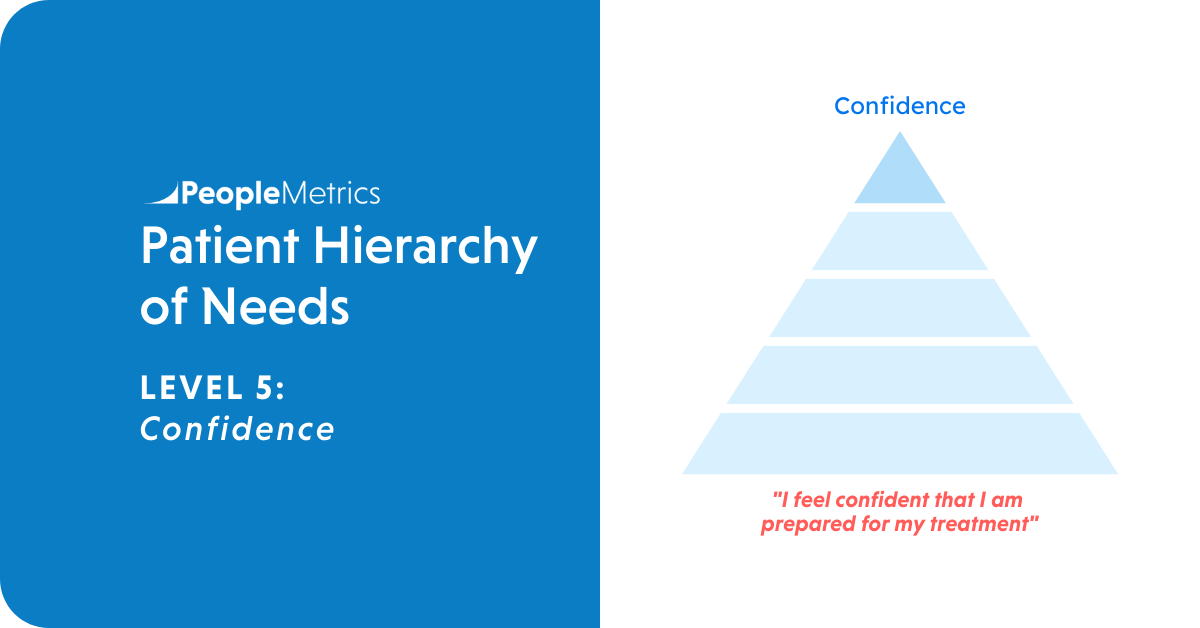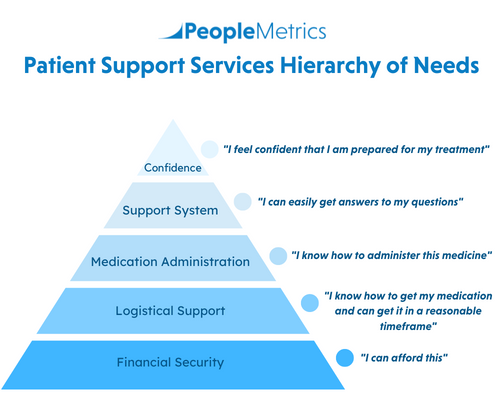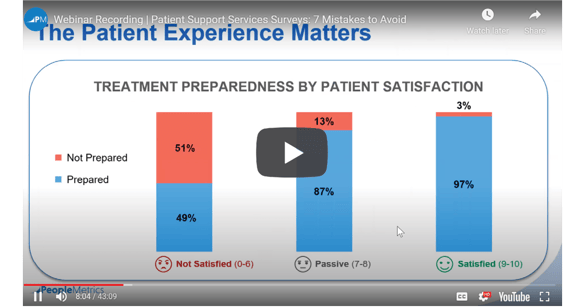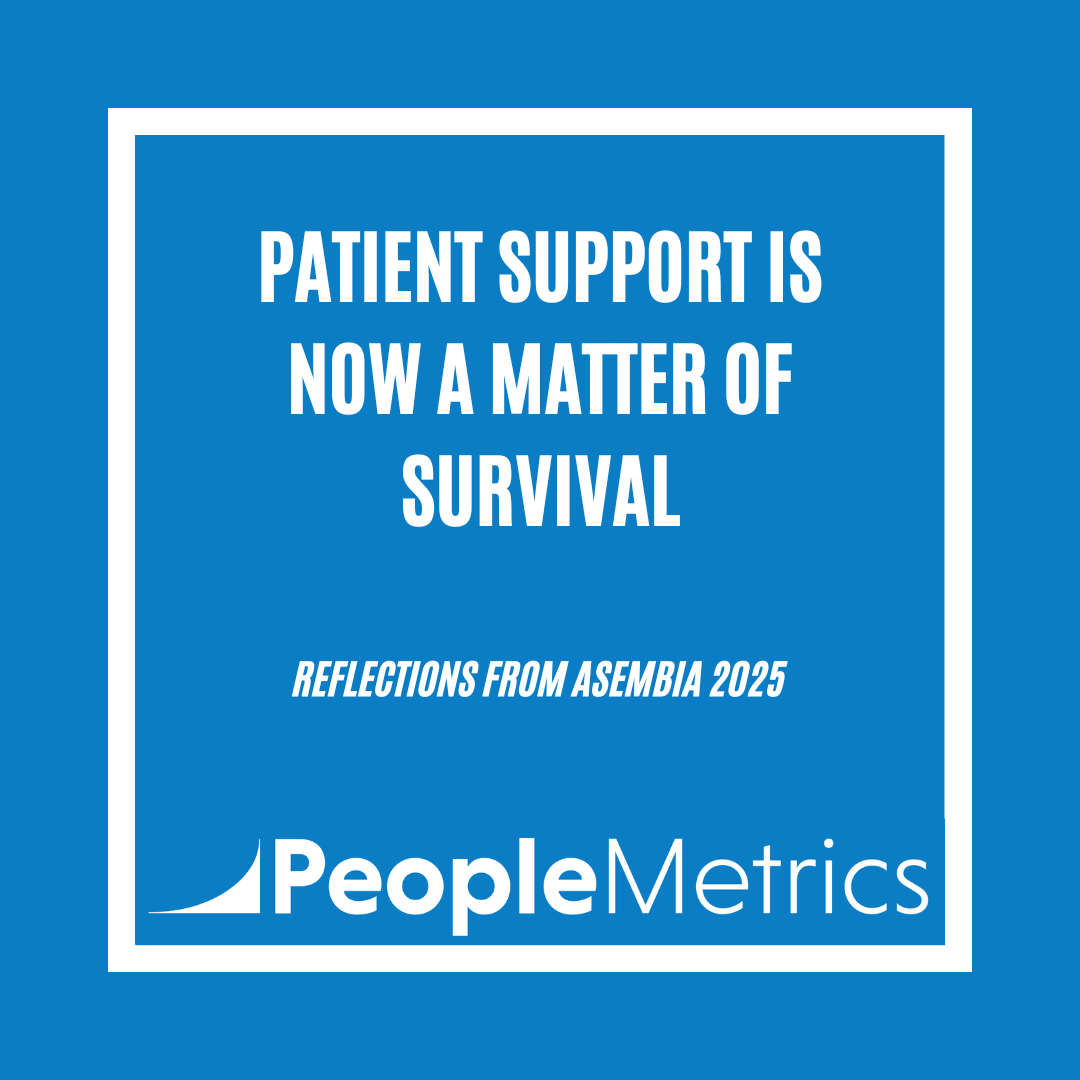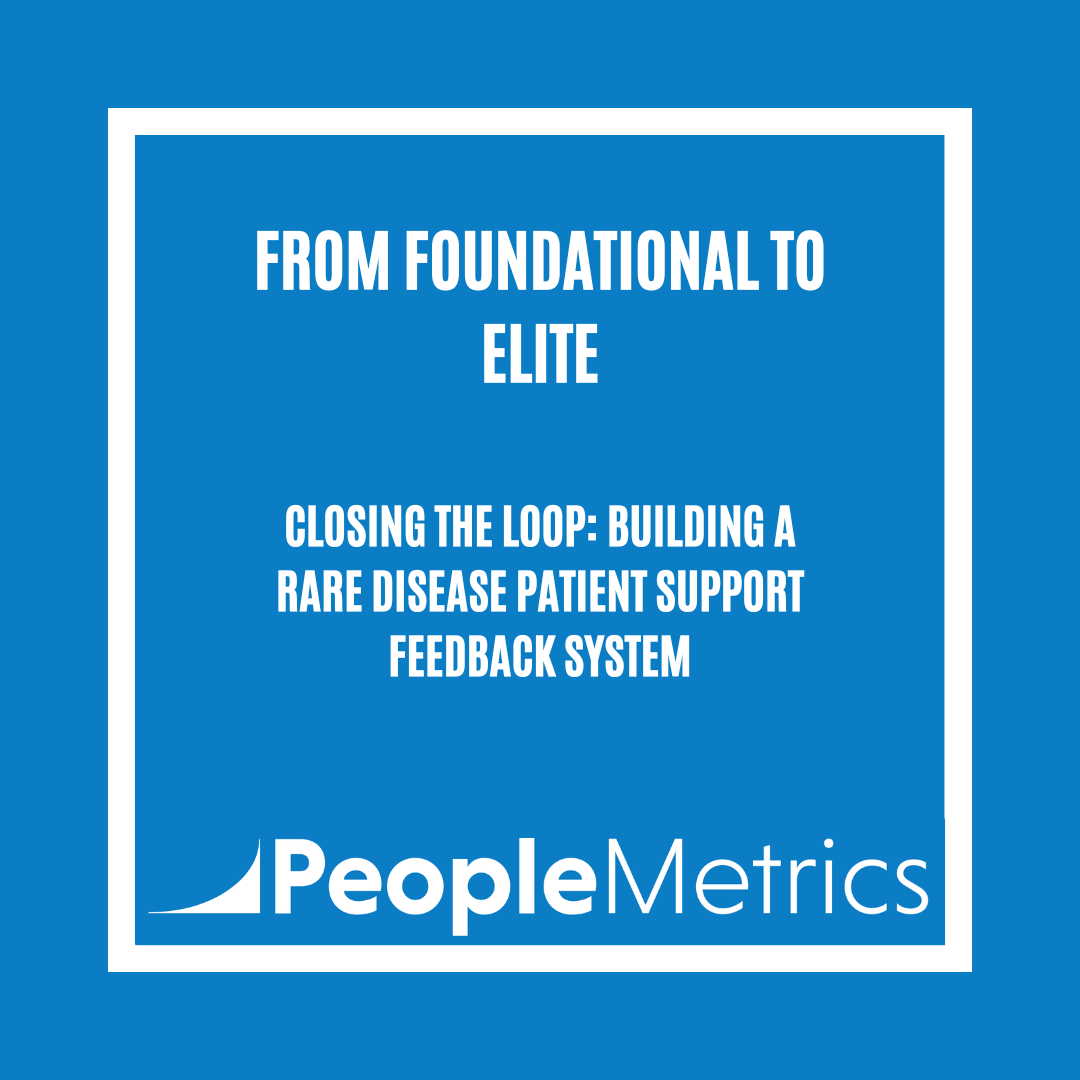This is the final part of a series of blog posts examining how Patient Support Services teams can deliver an outstanding patient experience.
Pharmaceutical manufacturers have increasingly focused on providing support services to patients in recent years.
The ultimate goal of providing these services, either through an in-house team or a partner hub, is to increase patient likelihood of onboarding to a new medication and adhering over time.
To help Patient Support Services teams measure and improve the patient experience, PeopleMetrics has developed a model called the Patient Hierarchy of Needs.
This model includes five core patient needs and 15 questions that link to each need:
This model is based on Maslow’s Hierarchy of Needs, whereby certain needs must be fulfilled before higher order needs become relevant.
Our model begins with financial security as the most important need – if the patient can’t afford the medication, nothing else really matters.
From there, we move into logistical support – patients must know where they can obtain their medication and they must be able to get it within a reasonable timeframe.
After these needs are fulfilled, patients need to know how to administer the medication.
Patients count on Patient Support Services to help them navigate these three fundamental areas (how to afford the medication, where to get it and how to properly take it) every single day.
Next, a higher order need is at the forefront - creating a support system to help patients get their questions answered.
The delivery of this support system depends on the type of medication.
Rare disease medications are often accompanied by a team of case managers that are dedicated to answering patient questions.
Mass market medications often deliver these services digitally through web sites, portals or apps.
No matter how you provide a support system for your patients, patients must feel that they are supported in their journey.
Once they do, we move into the fifth and final level of patient need – confidence:
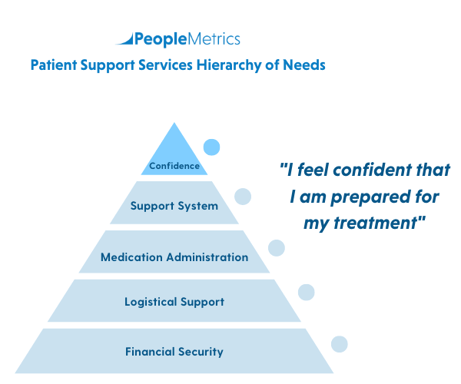
Is the patient confident they are prepared for treatment?
Is the patient confident that all their questions have been answered and they're ready to onboard?
This is the ultimate patient need, and the reason Patient Support Services exist in the first place.
Confident patients onboard.
Patients who aren't confident might not.
Level 5: Confidence
So, what’s the best way to measure confidence?
In our model, we have three questions that measure patient confidence:
1. Net Satisfaction Score
"Net Satisfaction Score" asks patients how satisfied they are with the overall process of receiving their therapy. This question is asked with an 11 point scale (where 0 = “Not at all Satisfied,” and 10 = “Extremely Satisfied”)
We ask this question on an 11 point scale (similar to Net Promoter Score (NPS)) so we can create segments of patients in terms of their overall satisfaction with patient support services offered.
Patients who answer 9 or 10 are considered Promoters. They are confident and ready to onboard.
Patients who answer 7 or 8 are considered Passives. They are likely to onboard, but still have outstanding concerns.
Patients who answer 0 to 6 are Detractors. There is a real chance they will not onboard.
2. Open-Ended Patient Comments
Immediately after the overall satisfaction question, we ask patients a follow-up open-ended question asking them to explain their answer.
This open-ended question allows patients to write, in their own words, why they feel the way they do about their experience with patient support services.
There is gold in these words.
These patient comments will give you clues as to what is working within your patient support services program and what is not.
Since onboarding and support needs are distinct for each medication, open-ended feedback is critical for getting specific details on what patients find difficult about your process.
But be careful – make sure your partner has an adverse event reporting process in place.
While it's rare for patients to share adverse events from their medication here, it does happen, and when it does, it must be reported immediately.
3. Treatment Preparedness
Confidence is more than just satisfaction, though - it also involves the patient feeling prepared.
The final question we use to measure patient confidence is as follows:
- Do you feel that your experience with [COMPANY] and [CASE MANAGER] has adequately prepared you to begin treatment?
- Yes
- No
We originally asked this question as a 5 point agreement scale, but found that the yes/no dichotomy gave us more reliable results.
This is the ultimate question to measure patient confidence.
Patients that don’t feel prepared for treatment usually have an outstanding issue within the first four levels of the Patient Hierarchy of Needs relating to support, medication administration, logistical support, or financial access that is causing them to stop short of feeling confident for onboarding.
As such, it’s no surprise that these outstanding issues have a major impact on those patients' likelihood to onboard.
In our work with Pharmaceutical manufacturers, we have found those patients who answer “Yes” to the preparedness question almost always onboard – 99% of the time.
Patients who answer “No” to the treatment preparedness question, however, do not onboard more than 1/3 of the time!
That obviously has major implications.
In fact, this is so important to our clients that most set up an alert to notify them immediately if a patient indicates that they are not prepared to begin treatment.
Whenever this happens, an email goes right into their inbox so they can then follow up with that patient and see what can be done to make them feel more prepared and confident to begin treatment.
It’s a game changer.
I hope you have enjoyed our series of blog posts on how to deliver a patient experience that fulfills key patient needs and drives key outcomes. Check out all of the posts from this series here:
- Introduction to PeopleMetrics' Patient Hierarchy of Needs
- Level 1: Financial Security
- Level 2: Logistical Support
- Level 3: Medication Administration
- Level 4: Support System
- Level 5: Confidence
○ ○ ○
About the Author
Sean McDade, PhD is the author of Listen or Die: 40 Lessons That Turn Customer Feedback Into Gold. He founded PeopleMetrics in 2001 and is the architect of the company’s customer experience management (CEM) software platform. As CEO, he guides the company’s vision and strategy. Sean has over 20 years of experience helping companies measure and improve the customer experience. Earlier in his career, he spent five years at the Gallup Organization, where he was the practice leader of their consulting division. His company offers CEM software with advanced machine learning solutions and hands-on analytical support to help companies make sense of their CX data. Sean holds a Ph.D. in Business Administration with a specialization in marketing science from Temple University in Philadelphia. He has published eight articles in peer-reviewed scholarly journals and has taught over 25 marketing classes. Sean was named a 40 under 40 award recipient of the Philadelphia region. He is an active Angel Investor, including investments in Tender Greens, CloudMine and Sidecar.
Topic: Pharma CX

